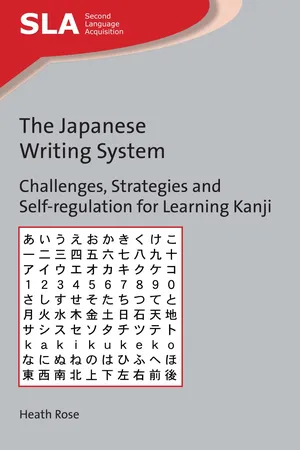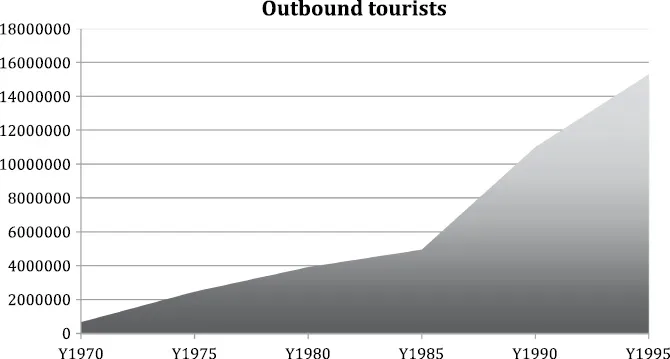![]()
Part 1
Issues Surrounding Japanese Language Acquisition
![]()
1Introduction
An Overview of Japanese Language Education
The teaching and learning of Japanese language around the world is a relatively new area of study compared to traditional European languages, with most programs being established within the last 40 years. As such, relative to other European languages, little is known in regard to how it is acquired as a second language. Unlike the learning of European languages by other European language speakers, the learning of East Asian languages has predominantly developed after the Second World War. Interest in the learning of the Japanese language in Western countries was largely due to globalization, which brought the East and the West closer together economically and politically. Japanese language education first grew from the increasing economic strength of Japan, beginning in the late 1970s and early 1980s. One driving force for language education growth was in response to an increase in tourism from Japan around the world. With a stronger economy came an increase in population mobility, which brought European language speaking nations such as France, the UK, the USA and Australia into direct contact with large numbers of Japanese tourists for the first time. The numbers of outbound tourists leaving Japan during this economic boom skyrocketed, as can be seen in Figure 1.1.
Figure 1.1 Outbound tourists from Japan
Source: Japan Ministry of Justice
Also during this time, the global economy saw an influx of trade with Japan and closer economic and political relationships. In the 1970s, Japan grew to be the world’s third largest economy and the nation soon became the second largest economy by 1980. With the growth of Japan on the global stage, the need to learn Japanese as a foreign language naturally grew. Nations such as Australia and the USA were quicker than others to fill a need for Japanese language programs, perhaps due to strong Pacific trade ties.
Interestingly, despite its recent entry among language study options, Japanese language education around the world has boomed (Bramley & Hanamura, 1998). Notably in the USA, Australia, New Zealand and the UK, the number of students enrolled in Japanese courses increased dramatically in the 1980s and 1990s, leading to the growth of Japanese language programs at the university level (Komiya-Samimy & Tabuse, 1992). In Australia, for example, Japanese quickly rose to prominence due to state government initiatives such as those by Education Queensland, which elevated Japanese as a major language study option in Queensland’s public schools in the 1980s. Much of this push by governments in the 1980s to learn Japanese was due to financial incentives related the booming tourism and economic trade associated with Japan at the time.
Furthermore, Japan was viewed as a traditionally a monolingual, monoethnic and monocultural country (Noguchi & Fotos, 2001), with 98% of the population categorized as ethnically Japanese (Suzuki, 2006). Thus, there was a much larger perceived language barrier to overcome when conducting business with Japan as opposed to other Asian economic powers at the time, such as in Hong Kong and Singapore where English was widely used as the lingua franca of certain segments of education and governance. It was, therefore, deemed more desirable for students to learn Japanese in order to take advantage of these economic benefits compared to other Asian market countries, where English was more widely understood and used (e.g. Singapore, Malaysia and Hong Kong). For these reasons, the major driving force in the boom of Japanese education was largely due to government educational policy in countries that wanted to increase economic trade with Japan.
When the bubble economy of Japan burst, so did some of the driving forces for governments to promote Japanese language education. In the 1990s and 2000s, other languages such as Korean and Chinese rose to prominence for the very same reason that Japanese was promoted in the 1980s. These days we can see a similar situation to Japanese language education in the 1980s occurring in the push to learn Mandarin Chinese as a foreign language, in response to China’s rise as the current second largest global economy.
Despite the economic shift in focus, however, Japanese language education has continued to boom around the world, although students’ current reasons for wanting to learn it as a foreign language are no longer wholly centered on economic reasons. With the economic rise to prominence of Japan in the 1980s came an increase in cultural interest in Japan. The younger generation around the world, who had grown up knowing Japan as a world economic power, were also exposed to cultural aspects of Japan. This exposure in turn sparked interest in travel to Japan and interest in learning the Japanese language and culture. More recently, the world is witnessing an explosion of interest in anime and manga around the world, further fueling the younger generation’s desire to learn the Japanese language and to go to Japan to study and experience Japan first-hand.
Evidence of the continued boom in Japanese language learning can be found by examination of the number of students taking the Japanese language proficiency test each year, which is an international, standard test of Japanese ability. The number of examinees in 1993 was 80,000, compared to 270,000 in 2003 and 560,000 in 2008 (Japan Foundation, 2009). Recent statistics from the Japan Foundation’s Survey Report on Japanese-Language Education Abroad (Japan Foundation, 2013) also highlight an increase in Japanese language studies around the world. Table 1.1 shows the top 10 countries by Japanese language learners, with the change from 2009 to 2012 shown.
Table 1.1 Number of Japanese language learners |
| | 2009 | 2012 | Change (%) |
1 | China | 827,171 | 1,046,490 | 27 |
2 | Indonesia | 716,353 | 872,411 | 22 |
3 | Korea | 964,014 | 840,187 | −13 |
4 | Australia | 275,710 | 296,672 | 8 |
5 | Taiwan | 247,641 | 233,417 | −6 |
6 | USA | 141,244 | 155,939 | 10 |
7 | Thailand | 78,802 | 129,616 | 65 |
8 | Vietnam | 44,272 | 46,762 | 6 |
9 | Malaysia | 22,856 | 33,077 | 45 | ...

